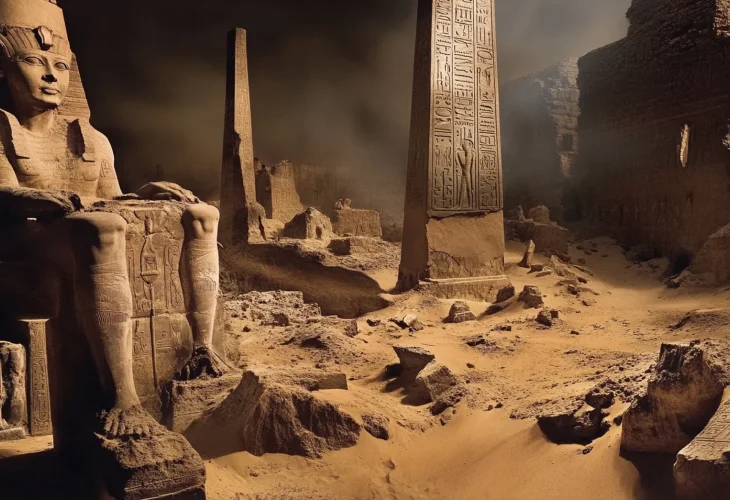The Mysterious Fall of Tanis: Unearthing an Ancient Enigma
The discovery of Tanis unveiled a breathtaking yet terrifying landscape. As the sands parted, they revealed a ravaged cityscape as if mythical beasts from a fantasy had mangled its towers and reshaped its earth.

Have you ever heard of Pharaoh Smendes? Probably not. He was a rather dull Pharaoh, living in the meek times of Egypt, the 11th century BCE, over a hundred years after the Exodus. Egypt was humbled and defeated, losing control over Sinai and Canaan, while southern enemies bit into its territories. No traces remain of the Pharaoh from the time of the Exodus or his dynasty; they vanished from history. A new dynasty emerged in Egypt, attempting to restore its glory. This was the 21st Dynasty, starting with our pal Smendes. Almost nothing is known about him, not even a Wikipedia entry. Little did he know... He set his capital in Tanis after Pi-Ramesses sunk into the sands. Due to Egypt's weakness, parts came under the control of other groups, each with its own capital. Yet, Tanis remained relatively significant during that time. Pharaoh Smendes reused stones from the sunken city of Pi-Ramesses, turning it into a quarry to build Tanis, which served as the capital for several centuries.
The prophet Isaiah writes, 'The officials of Zoan are nothing but fools, the wise counselors of Pharaoh give senseless advice' (Isaiah 19), implying that Zoan was the capital in his day. Zoan's name resembles Tanis, sparking identification theories. Moreover, a large mound named 'San el-Hagar' in the Tanis region closely resembles the name Zoan. The founding of Zoan was noted in the ancient world, as the Torah writes: 'Hebron was built seven years before Zoan in Egypt' (Numbers 13:22). Even a stela from the days of Ramesses I, discovered at San el-Hagar, marks 'four hundred years since the construction of Zoan.'
Tanis is nestled deep within the Nile Delta, about a three-and-a-half-hour drive from modern Giza, home to the famous pyramids. Its identification as Tanis—Zoan, and subsequent study, began approximately eighty years ago by French archaeologists.
The sight upon uncovering Tanis was both stunning and horrific. As the sand was washed away, it revealed a city slashed and fragmented, as if monsters from a sci-fi movie had trampled over it, twisting giant towers, tearing the ground, and overturning tombstones weighing tens of thousands of tons. Researchers precisely sketched this eerie spectacle. Like Hashem's upheaval of Sodom and Gomorrah, one researcher remarked. But who or what demolished this city?
In Tanis stood humanity's largest statue ever constructed, carved from a solitary block of granite, standing 28 meters tall and weighing around 1,100 tons. It was hewn in Aswan and transported a thousand kilometers away! This was long after the obscure Pharaoh Smendes. Great kings like Shoshenq, who even conquered Jerusalem, adorned Zoan with monumental structures. But these edifices were destroyed, and the colossal statue turned to rubble. Did a monstrous giant wield an immense hammer to smash it?
Tanis was once depicted as a lush and flourishing city, but today it sits in the heart of a desert. There's evidence a Nile branch, the 'tanitic arm,' once flowed here, but mysteriously dried up, leading to the city’s decay and ruin.
We can’t help but recall Ezekiel's prophecy on Zoan: 'Thus says the Lord God: I will destroy the idols and put an end to the images in Noph; there will no longer be a prince in the land of Egypt; and I will put fear in the land of Egypt. I will lay waste to Pathros, set fire to Zoan... and I will set fire in Egypt; Sin will be in great anguish and No will be torn apart' (Ezekiel 30). Could this fire have been the catalyst for Tanis’s destruction? Some stones at the site indeed show signs of exposure to extreme heat. To melt granite stone, a tremendous furnace-like heat is required, a level a mere fire couldn’t achieve!
History books claim the city was 'abandoned,' but researchers discovered it wasn't deserted. Massive treasures lay buried beneath. People moving don't leave behind their riches... Golden masks, silver figures, jewelry encrusted with diamonds—this city wasn't merely abandoned; it was struck by a catastrophic blow, turning it into a fearful place no one dared approach for centuries until it faded from memory.

